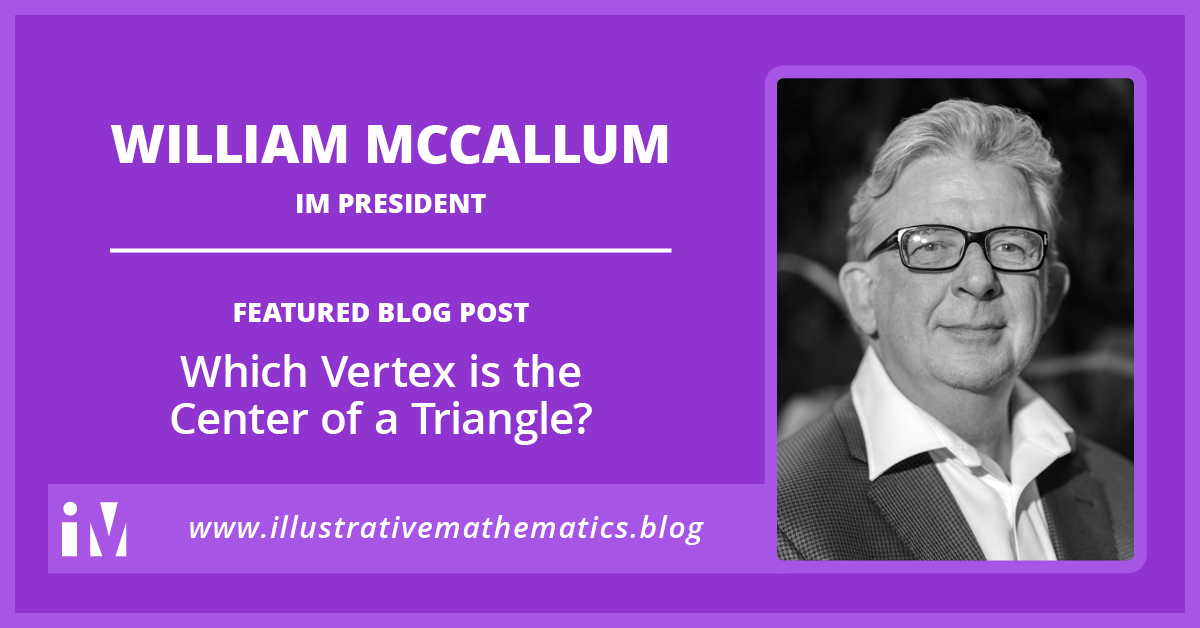By William McCallum
I am sometimes asked what is the secret to the success of our curriculum, what is the special property that sets it apart from other curricula. That question is like the one in the title of this blog post, “Which vertex is the center of a triangle?” It doesn’t have an answer. None of the vertices is the center of a triangle; all three are equally necessary for it to exist. Similarly, all three vertices of the instructional triangle—students, teachers, and content—need equal attention in the work of teaching mathematics. And not only the vertices but the arrows between them, which “represent the dynamic process of interpretation and mutual adjustment that shapes student learning [and] instructional practice.”1 If there is something special about what we do in writing curriculum it is to pay equal attention to all parts of the instructional triangle.

The arrows among students at the bottom left represent the process of students talking and listening to each other as they share their reasoning. Many of the activities in our curriculum are designed to support this process, for example by having students compare their methods of solving a problem and make connections between them. Research shows that explicitly attending “to connections among mathematical facts, procedures, and ideas”2 promotes both conceptual understanding and procedural skill.
The arrow between students and teachers represents a complex set of interactions requiring continual adjustment by both parties. Teachers make in-the-moment decisions about how to respond to student thinking, and students make sense of problems posed by the teacher and ask productive questions. In our curriculum we support this process through instructional routines which orchestrate the work of both teachers and students, giving structure to this complex set of interactions and relieving a lot of the logistical burden on both teachers and students. We also support it by offering teachers guidance on things to look and listen for and suggestions on how to respond.
We also put a lot of thought into the arrows between content and the other vertices. We designed coherent progressions of activities and lessons that tell the story of a mathematical idea, so that both teachers and students can see why one skill or concept comes before another. We designed our curriculum to support problem-based instruction. Note that problem-based instruction does not mean frustrating students with big, complex problems that are beyond their reach. It’s like teaching a child to ride a bicycle: You need to let the child try things out for themselves, but you also need to be there ready to support the child. Too much explaining before allowing the child to give it a try isn’t helpful, but neither is withholding help and expecting the child to figure it all out entirely on their own. One of the most robust findings from research is that students learn by productive struggle, “solving problems that are within reach and grappling with key mathematical ideas that are comprehendible but not yet well formed.”3 Many structures in our curricula are designed to help students make the transition to this way of learning, such as invitations to the mathematics and concrete representations.
Finally, we made strides in addressing the arrows to the outside environment through our culturally sensitive choice of contexts and character names, supports for English learners and students with disabilities, and family support materials. In the K–5 curriculum we also provide opportunities for students to discuss math in their world outside of school. In addition to the curriculum materials, we think a lot of the work needed to address this instructional triangle component takes place in professional learning with teachers.
I don’t want to suggest we got everything right the first time; we still have a lot to learn from our community of users as they implement our curriculum. But I do think our fanatical attention to balancing the elements in a complex system is one of the reasons we have made a good start. The key to our curriculum is that there is no single key, but rather attention to the big picture, to lots of details, to the way they all fit together, and to trusting in the expertise of professional teachers.
1Ball, D. L., & Forzani, F. M. (2007). 2007 Wallace Foundation Distinguished Lecture—What Makes Education Research “Educational”? Educational Researcher, 36(9), 529–540. p. 531
2 Hiebert, J., & Grouws, D. A. (2007). The Effects of Classroom Mathematics Teaching on Students’ Learning. In F. K. Lester Jr. (Ed.), Second handbook of research on mathematics teaching and learning (pp. 371-404). Charlotte, NC: Information Age.
3 Hiebert, J., & Grouws, D. A. (2007). The Effects of Classroom Mathematics Teaching on Students’ Learning. In F. K. Lester Jr. (Ed.), Second handbook of research on mathematics teaching and learning (pp. 371-404). Charlotte, NC: Information Age.
